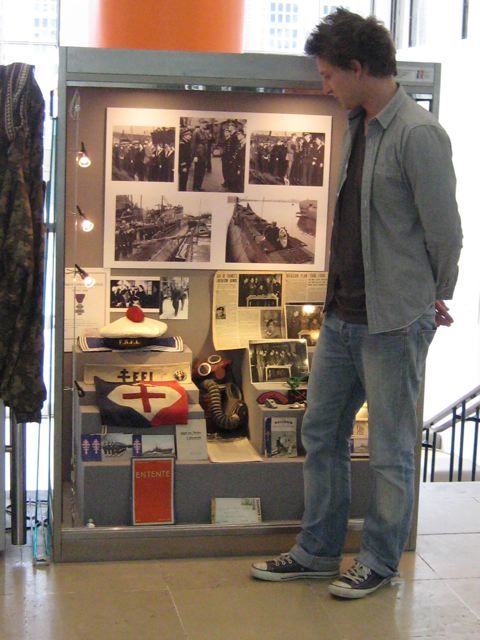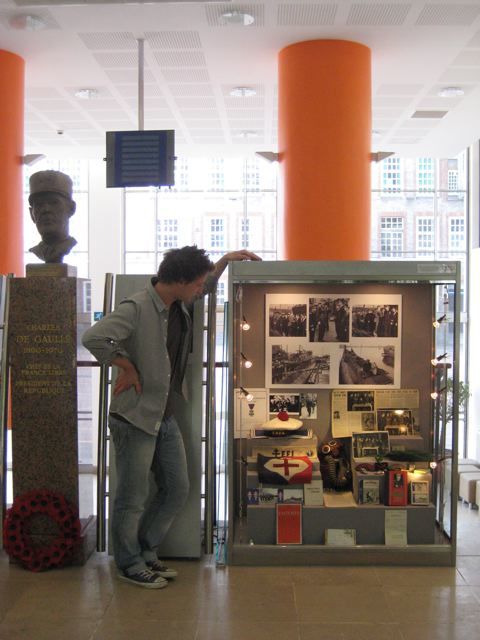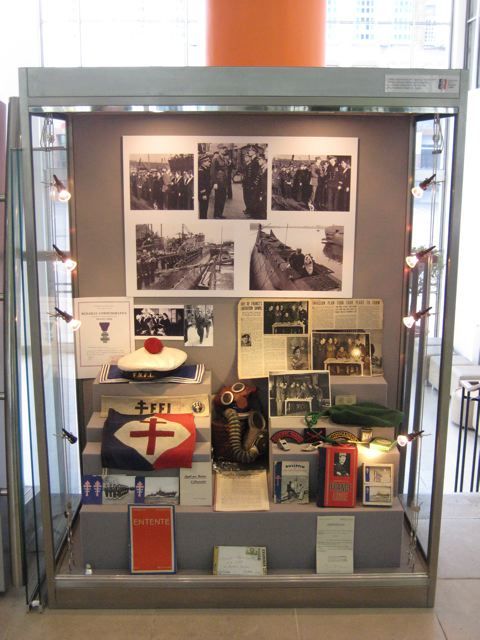Ddiscuss the role France has played in various wars in and over its territories. The main interest will (I hope) be the first & second world wars, but we’re led by you. Hope you enjoy the discussions.
I am author of five ebooks called Pilgrimage. May I share, a little poetic piece inspired by the Marques of the Drome, A Trouser Ecology.
In the morning, there are soft showers, cold cascades and ice, born on Venterol's sleeping slopes. Within hair's breathe of my cold weapon, I reach for my wife, breath of hair, a back to stroke - cheek of the Marque - only soil and single blanket nestling with me. Armpit reality, a whiff of shiftiness, brotherly air; when the microscopic invades your scalp, and Nazis your land, all shall itch. Brothers call for action, and leaders for patience.
.
We hid the refugee, the airmen and escapee; learning regimen and drill, pushing will up hills to cache and carry. Our legs bear us along our Baronnies path, driving my trousers to the world's end, blending with the local ecology, seeing wild boar take secret notes from the hillside tussock, trousers and I climbing, following the path of Free France of the farm, hoe and rifle, plough and gun, ready for some-day-soon. The years shall drive Nazi's ragged.
.
We are men and womenfolk of the trouser ecology, going where the enemy dare not, looking over the embittered valley, our doctor harassed and shot, teachers beaten before roses, our men conscripted to German factories, bloody oath. Fondly we look to Venterol and Valreas, the mighty Rhone groaning that liberation is borne of worn trousers and dirty socks. We have the upland of soiled reality, watershed before my eyes, lashes entangled in sleepy pining, swamp aromatics, upright nipples, forehead making the Alamo, spectacles of our selves, neckerchief surrounding me, imagining two Nostradamuses coughing and spluttering the future, their easy metaphor and empty promise a curse on tillers of soil. With only blades of grass, free peoples are made of standing tall.
.
In the presence of our trouser ecology, our leader speak of the springs that well beneath our shoes, that flow from the hills and into the valley, nurturing all the fruits of liberty. We farmers forbid optimism, the grace to fine words my offspring toes wiggling, knees a wildlife refuge, inner thighs full of gorillas and toads, stomach rapt in rags. Itchiness is spiky time, all of us thinking some-day soon, some-day-soon, my trousers bearing the years, as interlude to victory.
This piece is found in Pilgrimage Five. Feedback welcome.
https://www.smashwords.com/books/view/355453 It's only US$1.99, PDF recommended.
In our departement (Cher) we have a Musee de la Resistance at Bourges.
http://www.resistance-deportation18.fr/?lang=fr You can probably get it in english
And finally,
You are too proud to market your pain maudin, your Lochness monster of viperous conspiracies, all excitement and fantasy, no one’s willing destiny. Pursing your lips, you will not parry windmills like Don Quotote. Let the tourists feed themselves dates- Pont Saint Esprit (1265/1309), Priory of St. Pierre (12th-18th centuries), Church of St. Saturnin (15th century), Collegiate church and citadel (14th-18th centuries)- quiet respect and affection afforded you by sparkling eyes and curious children. Many visit Maison des chevaliers, review Chez Paul Raymond’s or sit in bars and cafes in weak sunlight. After an exhausting day at Gorges de Ardeche, Aiguese or, St Martin, they call for music, enjoy the inn’s frothy drink, tankard hard against their lips, and merriment tonight.
Here's the rest of the story:
With roads aplenty, wheat growing lush amongst grasses on fringe, the Rhone soils, of-the-Gods, the merchants of wheat found you, dear ville, the Piolenc family planted here, backs to the river, counting money in the Maison des Chevaliers, its Romanesque facade gifting rue St Jacques, lent to the King’s men, dispensing justice, accumulating wealth over time, the bridge harvester for merchants, lords and kings.
Step forward. Your war against Hitler traded lives. your bridge, town, railway and yards- target practice for sky raiders. So you laughed that kind of laugh. You raised your eyebrows and lowered your lips, reading grimly 445th Air Squadron war diary:
August-eight, nineteen forty-three: squadron bombed the Pont S. Esprit railroad bridge once again, this time achieving a bombing accuracy of 82 per cent – a decided improvement.
Chewing your bread day and night, mouth closed, persisting until resistance won through, hiding under the arching bridge, Nazis with guns overhead, retreating. A great hurrah, men and women looking to town, no need for funerals or blessings, only the inn’s frothy drink, tankard hard against your lips, and merriment tonight.
Harvest your wheat freely once again, chew your bread, until,ø in fifty-one, it poisons you. Mass poisoning in Pont St Espirit. Postman Leon Armunier fell off his bike, feeling himself shrinking and shrinking, suffering stomach pain and nausea, fire and serpents coiling around him. Other suffered attacks in their hands, anus and feet, or severe fainting. Shrinking! Fifty espiripontains hullicinating, visions of flames and animals, macabre and mystical. Jump out the window, straight jackets worn, like its going out of fashion. Seven died.
Ergot they said, or St Anthony’s Fire, pain maudin (‘cursed bread’), and Mal des Ardents, viruses, fungi, or LSD as proffered causes, psychosis, dead and hocus pocus the result. Ergot, CIA, LSD, C6H5HgOCOCH3 to some, madness, conspiracy and surely fertile ground for BBC, Telegraph and USA Today.
So you grow kindly, stoic and tough ma ville; nuclear power stations built upriver, grand canal too, ten thousand people, two musee, urbane repose, streetside cafes, bars and fruiterers, roundabout so civil. Some call you ‘small’, ‘typical’ and even ‘unremarkable’. J’ami!
Today new railways, motorway and airports bypass town and bridge, now you stand graceful and languid guard of the forgotten roads between the Gard, Dome and Provence, kept alive by maps, music, reference books and hotel de ville. You comfort yourself with Bouvier oils, flowing Ardeche waters, proximity to L’Orange and Avignon, quite conversation and laughter. No need for sleep. Cabinetmaking is grand work, daughter Jackie becoming a Kennedy, a king of sorts in legendary America, full of knights and shining armor.
Only cities matter now. Few desire you, the river whispering you are free and irrelevant, that people will holiday in your never regions, ride bicycles around your eyes, canoe down the small of your back, buy jams for the tongue, conjure recipe for olives and see friends from other places nestling in anonymous hotel chambers with a view.
Interested in finding mor info on the ww2 French resistance. Visited Cahor musee, and glimpsed a fascinating (and deadly) era. But my French isn't good enough (yet). Is there a place and/or book that I can read info in English? I'm in France and Spain (for the umpteenth time) in April. May and June. All ideas welcome.
For your info, here's a written piece found in my Pilgrimage books (Smashwords)' Tribute to Pont de St Espirit' (on the rhone) mentioning WW2. It is sans photos, graphic etc.
Tapis Pilgrimage
Tasty Tales of Spanish and French Pilgrimage Towns
Garry McDougall © 2012
Pont St Espirit is a town and brridge half way between Marseille and Lyon, close to four regional borders: Ardesche, Languedoc, Drome and Provence.
Pont de St Espirit, bridge of seven century’s standing, tribute to saints and engineers rediscovering Rome and Greece, many arches across the shallows and rapids de Rhone, only crossing for a hundred kilometres, river and bridge a singular crossroad for trade, road and river, goods floating one-way, downstream, rapids ahead, vessels approaching dangerous waters, low and high, wild and weary. This is what you’re paid for sailor boys!
Position your vessel, battened down the goods, eyes high-wiring dead man’s drop, time freezes, lashing waters surrounds you, every lurch and lunge hard pressed on wood, forehead of nails, groaning timbers, straining ropes, vessel sliding under bridge, captain’s demands, everyone cursing, over arching figures peer from above, not God but a man and woman praying in rain and bleached by summer’s song.
Through. Through. Through; vessel and crew stirring green waters, drowned goat knocking against against your hull, four legs stiffly pointing skywards. A giant hurrah, every man looking to town, no need for funerals or blessings, only the inn’s frothy drink, tankard hard against your lips, and merriment tonight.
Pont de St Espirit’s destiny is tied to grim, determined town twin, its walls butting against river waters, steps, stained and grimey, merging to streets, church and dome, saintly spectators of every passing day and vessel, front row seat to trade, popes and bishop, knights and lords, wide waters of peasantry, impervious to drowning souls, armored by stone, blackened by lichen, the old town hard against the river, stone passageways beckoning those with legs, its shops and inns like secrets dark, this town married to a bridge.
Hi all, I'm new to the group and realising quickly from the comments I'm clearly in deeply auspicious company! You've all got fascinating stories and obviously a wealth of knowledge between you. I'm sure my story is one you've heard many times before on here, my dad is somewhat of an unofficial authority on all matters 2WW related so I grew up being surrounded by films and books on the subject. When my husband and I moved to France - we're in Haute-Vienne, 87 - we weren't aware of the extent of the Resistance history in this area, but we've been researching and absorbing it all since we arrived. I'm developing a library bit by bit but would welcome any information, tips or suggestions that you may have - I'm trying to confine myself mostly to this particular region, and there's a wealth of history and material therein here, not least because we're so close to Oradour-sur-Glane (it's about a 35 minute drive from us) and 2 Resistance museums in Limoges and Angouleme.
I'd really be most grateful for any assistance you are able or willing to give me in my research - many thanks and best wishes to you all for the weekend, stay warm everyone!
Charlotte
Hi I'm ew to this group. Living in Australia, but frequent visitor, sometime working in Spain and France. I went to the Resistance museum in Cahor, nit want other sources of info. Can anoyone recommend their best WW2 resistance museum, contact and/or book? I am visiting again in April, staying until july.
Re Oradour sur Glane
I visited Oradour a little while agoon a hot, sunny afternoon, pretty much like the weather reportedly was when the atrocity committed by the Nazis took place. Spent most of the afternoon quietly wandering around the village, taking in the ruins and what had happened. I found it obviously interesting but I felt very uncomfortable and disquieted not by what I was seeing but by what I was sensing. To some it may sound fanciful but there were definitely people there other than visitors, quite a number that I could sense.
I do not particularly want to return but feel that I must when I am better prepared for those that perished there.
Live near Montaut, Villeréal 47. Along the road from Montaut to Ferrensac there is l'eglise de St Martin (signposted). Beneath this church their is a vault, would not describe it as a crypt, to which the only access is externally via a couple of holes in the ground below the walls where it is reputed that arms etc were cached during WW2. Known to have been raided by German forces on at least one occasion.
In nearby Villeréal and Lougratte it is said that there were resistance groups which were liquidated in 1943 by the Germans.
I just want to say that I am a real lover of WW2 history and I would welcome any discussion on this subject - especially anything to with D-Day ...
Moving south soon to become Superintendent of the Rhone American Cemetery in Draguignan. I’m looking forward to telling the stories of soldiers who fought in Operation Dragoon.
www.abmc.gov
http://www.abmc.gov/cemeteries/cemeteries/rh.php
I was in the Dutch Underground Resistance (age 5 to 7)and took people who were hiding in our house to a ‘safe’ house, from where they were guided, via the famous 'Pilot Line’in France, to England, or Portugal.
I am officially recognised as a member of the Underground Resistance and receive and honorary pension from the Dutch Foundation 1940-1945.
I wrote a book about it - Rachel Sarai’s Vineyard - which I withdrew from publication twice, due to the foul harassment of hoax-hunting fanatics, Sharon Sergeant of Misha de Fonseca’s Surviving with Wolves fame included.
Have some copies left of the 2nd edition, called a novel, not an autobiographical novel. If you’re interested, give me a shout and I’ll send you one. After all, Resistance is Resistance, be it in Holland or in France, non?
Tonight (Dimanche 25 Sept.)at 22h40 TF1:
L’Occupation Intime
documentary by Isabelle Clarke and Daniel Costelle
These people make super docs about the Second WW. A ‘must-watch’ for me and I hope for many of you, too.
reasearching alot at the moment and wondered if anyone has any information about beziers and neighbouring towns and the part they played during the war.
Theses are pictures of the new display in honour of the Free French dedicated by the French ambassador at the Lycee in Cromwell Road in London on 18th June this year. The young man in the picture is my nephew, Daniel Montefusco and he is looking at a photo of my father, his grandfather, Vincent Montefusco.

I have some great books on the French Resistence during WWII. As you know, it was a very fractured effort because the communists and other groups wanted to take power after liberation and therefore, they worked against each other, a sure formula for failure. They turned each other into the Nazi’s to eliminate their rivals. What a disgrace that was for which France is ashamed.

